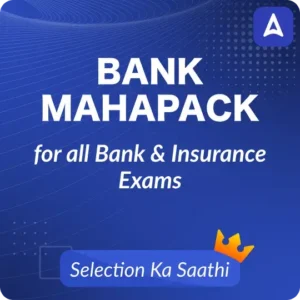With the Union Bank Specialist Officer (SO) exam fast approaching, there is no point in wasting time, especially when it comes to Quantitative Aptitude. This section plays a crucial role in determining your selection by testing not just your number-counting ability but also your logical thinking and real-world problem-solving skills. In this article, we present the practice question for the Union Bank SO.
Union Bank SO Quantitative Aptitude
The Quantitative Aptitude section in the Union Bank SO Exam 2025 demands more than just basic math skills it requires precision, speed, and a deep grasp of topics like arithmetic, algebra, number systems, percentages, profit and loss, ratio and proportion, averages, time & work, time-speed-distance, and data interpretation. With limited time in the actual exam, knowing the method isn’t enough you must apply it quickly and accurately. This practice set has been carefully curated to reflect the latest exam pattern and difficulty level, helping you fine-tune your problem-solving approach under real exam conditions.
Read Also: Union Bank SO Admit Card 2025
Union Bank SO Practice Set- Quant (With Answers)
Directions (1-3): In the given questions, two quantities are given, one as ‘Quantity I’ and another as ‘Quantity II’. You have to determine relationship between two quantities and choose the appropriate option
Q1. Quantity I. The perimeter of an equilateral triangle having height 12 cm and area 36 cm2.
Quantity II. Three years ago, the Sum of age of Babita and Savita was 24 years. Babita is 8 years older than Savita. Find the present age of Savita.
(a) Quantity I > Quantity II
(b) Quantity I < Quantity II
(c) Quantity I ≥ Quantity II
(d) Quantity I ≤ Quantity II
(e) Quantity I = Quantity II or no relation
Q2. Quantity I. Speed of the train (in m/sec.) having length 360 m which crosses a pole in 15 seconds.
Quantity II. Speed of the boat in still water (in kmph) which covers 240 km in 8 hours in downstream when the speed of current is 6kmph.
(a) Quantity I > Quantity II
(b) Quantity I < Quantity II
(c) Quantity I ≥ Quantity II
(d) Quantity I ≤ Quantity II
(e) Quantity I = Quantity II or no relation
Q3. Quantity I. Maximum possible difference between two natural numbers having an average of 30
Quantity II. Value of x.
20% × x + 1623 % of 96 = 25
(a) Quantity I > Quantity II
(b) Quantity I < Quantity II
(c) Quantity I ≥ Quantity II
(d) Quantity I ≤ Quantity II
(e) Quantity I = Quantity II or no relation
Q4. The cost of ploughing a square park at the rate of Rs 85 per square meter is Rs 3060. Find the cost (in Rs) of fencing the park at the rate of Rs 20 per meter.
(a) 420
(b) 400
(c) 440
(d) 460
(e) 480
Q5. There are three numbers A, B and C. The ratio of A to B is 2 : 5 while the ratio of B to C is 4 : 7. If the difference between A and C is 81 then find the average of the numbers.
(a) 60
(b) 69
(c) 54
(d) 57
(e) 63
Directions (6-10): What approximate value will come in place of question mark (?) in the following questions (You are not expected to calculate the exact value).
Q6. (14.85)2 × 4.75 + (45.02)2 × 3.99 = ?
(a) 9235
(b) 9245
(c) 9225
(d) 9255
(e) None of these
Q7. 239.96 × 6.21 – 124.57 × 1.83 =?
(a) 1190
(b) 1180
(c) 1170
(d) 1160
(e) 1150
Q8. (19.87)2 – 725.29 ÷ 24.99 = ? × 2 – 75.89
(a) 225.5
(b) 226.5
(c) 228.5
(d) 223.5
(e) 229.5
Q9. (4.96 × 5.03-2) ÷ (4.99-6)= 5?
(a) 9
(b) 8
(c) 7
(d) 6
(e) 10
Q10. (3/8) of 816 + 12.5 % of 32.11 = (?)2 + 84.92
(a) 15
(b) 12
(c) 11
(d) 10
(e) None of these
Direction (11-15): The Bar graph given below shows the total number of trees planted by five different schools (P, Q, R, S and T) and number of trees of type A and Type B planted by these schools. Read the data carefully and answer the questions.
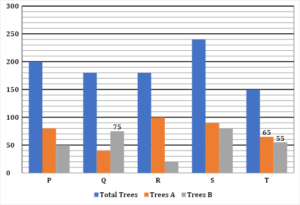
Note: Total number of trees planted by any school = Type A trees + Type B trees + Type C trees
Q11. Which school planted maximum number of type C trees.
(a) P
(b) Q
(c) R
(d) S
(e) Both P and S
Q12. Total type C trees planted by schools R, S and T together are how many more or less than total type A trees planted by schools P, Q and R together.
(a) 40
(b) 45
(c) 55
(d) 60
(e) 50
Q13. If the total trees planted by school X is 20% more than that of by school S, then find the number of type C types trees planted by school X, given that the ratio of type A, B and C trees planted by school X is 5: 6: 7.
(a) 118
(b) 116
(c) 120
(d) 115
(e) 112
Q14. Find the ratio of total type A trees planted by schools P and R together to type C trees planted by school S and T.
(a) 8 : 9
(b) 7: 8
(c) 5: 7
(d) 9 : 5
(e) None of these
Q15. Find the average of C type trees planted by all the schools.
(a) 55
(b) 57
(c) 58
(d) 59
(e) 51
Q16. A sum of Rs 4000 fetches an interest of Rs 1280 at x% p.a. on simple interest in four years. Find the compound interest (in Rs.) obtained on Rs. 7000 at the rate of (x + 12) % p.a. in two years.
(a) 2040
(b) 3080
(c) 5050
(d) 6040
(e) 2080
Q17. The distance between two points P and Q is 440 km. Car A starts from point P at 9 am at a speed of 55 kmph while car B starts from point Q at 11am with a speed of 45kmph. Moreover, Car A increases its speed at 12 noon by 15kmph. At what time will they meet if they travel at a constant speed.
(a) 2 pm
(b) 3 pm
(c) 4 pm
(d) 5 pm
(e) 6 pm
Q18. A, B and C can complete a work in 20 days, 30 days and 40 days respectively. All started the work together but B and C left the work 10 days before completion of the work. In how many days the whole work was finished.
(a) 5 days
(b) 10 days
(c) 161/13 days
(d) 178/13 days
(e) 190/13 days
Q19. How many kg of type A sugar costing Rs 20 per kg is mixed with 10kg of type B sugar costing Rs 30 per kg so that by selling the mixture at Rs 36 per kg there will be a profit of 50%.
(a) 20
(b) 10
(c) 15
(d) 25
(e) None of these
Q20. A and B started a business by investing Rs 7200 and Rs 8400 respectively. There was a condition that at the end of the year only 50% of the profit will be divided as per their investment and the rest 50% will be equally divided. If A received Rs 3900 as his profit then find the total profit (in Rs).
(a) 8112
(b) 7878
(c) 9100
(d) 7308
(e) 8188
Q21. When Ankit was born his father was 32 years old. Brother of Ankit is twice his present age. Average age of his brother and his sister is 14 years. If present age of his father is 40 years, then find the present age of his sister (in years).
(a) 10
(b) 12
(c) 8
(d) 6
(e) None of these
Q22. A man sold a bat for Rs 1000 and made 25% profit. At what loss % should he sell a ball worth Rs 400 so that net profit becomes zero.
(a) 20
(b) 25
(c) 30
(d) 35
(e) 50
Q23. The average age of 28 students in a class is 28 years. If the youngest and the oldest students are excluded then still the average age of the class remains the same. Find the age (in years) of the oldest student if the ratio of the oldest student to the youngest student is 4: 3.
(a) 32
(b) 36
(c) 28
(d) 40
(e) 44
Q24. A vessel contains 208 Liters mixture of milk and water in the ratio 7:6. If 52 Liters mixture is taken out and x litres water is added into the remaining mixture, then the ratio of milk to water becomes 6:7. Find the value of x.
(a) 22
(b) 24
(c) 20
(d) 18
(e) 26
Q25. Speed of boat in upstream is half of the speed of the boat in downstream. If the boat covers 64 km upstream and the same distance downstream in 24 hours. Find the distance travelled by the boat in 4 hours in still water.
(a) 24
(b) 28
(c) 20
(d) 32
(e) 36
Directions (26-30): In each of these questions a number series is given. In each series only one number is wrong. Find out the wrong number.
Q26. 7, 8, 10, 15, 40, 160, 880
(a) 40
(b) 10
(c) 8
(d) 7
(e) 15
Q27. 480, 300, 720, 180, 900, 150, 1050
(a) 480
(b) 180
(c) 900
(d) 300
(e) 150
Q28. 20, 33, 51, 81, 118, 161 214
(a) 161
(b) 81
(c) 33
(d) 20
(e) 51
Q29. 667, 395, 259, 192, 157, 140, 131.5
(a) 667
(b) 395
(c) 192
(d) 157
(e) 140
Q30. 4, 5, 11, 47, 264,1559, 9335
(a) 264
(b) 5
(c) 11
(d) 57
(e) None of these
Directions (31-35): The given pie chart shows percentage distribution of the customers visited in five different saloons (A, B, C, D and E) on Sunday and the table shows the ratio of the customers who went for hair cutting, massage and shaving in the respective saloons.
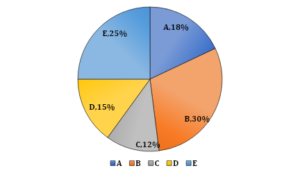
Note: The difference between the number of customers in saloon A and C is 150
| Saloons | Ratio of the customers who went for hair cut to massage to shaving |
| A | 2:3:4 |
| B | 4:5:6 |
| C | 5:10:15 |
| D | 3:4:8 |
| E | 7:8:10 |
Q31. Find the ratio of the customers who went for shaving in Saloon C to the customers who went for massage in Saloon D.
(a) 3: 2
(b) 2: 3
(c) 3: 5
(d) 4: 5
(e) 5: 6
Q32. The customers who went to Saloon D for shaving and massage together is how many more or less than the customers who went for haircut in Saloons C and D together.
(a) 125
(b) 150
(c) 175
(d) 225
(e) 250
Q33. The customers who went for shaving in Saloons D and E together are how much percent more or less than those who went for haircut in Saloons B and D together.
(a) 64 7/11%
(b) 65 7/11%
(c) 63 3/11%
(d) 63 7/11%
(e) None of these
Q34. Find the ratio of the customers who went for massage in Saloons A and C together to those who went for haircut in the same saloons.
(a) 5: 8
(b) 5: 9
(c) 15: 13
(d) 5: 3
(e) None of these
Q35. If in Saloon X, the number of customers who went for shaving, massage and haircut are 10%,20% and 20% more than those who went in Saloon A respectively, then find the total number of customers who visited Saloon X.
(a) 320
(b) 420
(c) 660
(d) 550
(e) 520
Solutions
S1. Ans.(a)
Sol. Quantity I.
Area of triangle = 36 cm2
12 × base × height = 36
12 × base × 12 = 36
Base = 6 cm
Perimeter = 3 × 6 = 18 cm
Quantity II.
Let the present age of Babita be b years and that of Savita be s years.
b + s = 24 + 3 + 3
b + s = 30 ……….(i)
b – s = 8 ………….(ii)
From (i) & (ii)
s = 11 years
S2. Ans.(e)
Sol. Quantity I. Required speed = 360/15 = 24 m/s
Quantity II. Downstream speed = 240/8 = 30kmph
Let the speed of boat in still water be s kmph
s + 6 = 30
s = 24kmph
S3. Ans.(a)
Sol. Quantity I. Average of two numbers = 30
Sum = 60
Let the smallest number be x = 1
Highest number be y = 60 – x = 59
Required difference = 58
Quantity II.
20% × x + 1623 % of 96 = 25
x = 45
S4. Ans.(e)
Sol. Area of the park = 3060/85 = 36 m2
Side = 6 meters
Perimeter of the park = 4 × 6 = 24 m
Required cost = 24 × 20 = Rs 480
S5. Ans.(e)
Sol. A : B = 2 : 5
B : C = 4 : 7
A : B : C = 8 : 20 : 35
Let A, B and C be 8x, 20x and 35x respectively
ATQ,
35x – 8x =81
27x = 81
x = 3
A = 8x = 24
B = 20x = 60
C = 35x = 105
Required average = (24+60+105)/3 = 63
S6. Ans.(c)
Sol. 152 × 5 + 2025 × 4 =?
1125+ 8100 =?
? = 9225
S7. Ans.(a)
Sol. 240 x 6 – 125 x 2 =?
1440 – 250= ?
? = 1190
S8. Ans.(d)
Sol. (20)2 – 725 ÷ 25 = ? × 2 – 76
400 – 29 = ? × 2 – 76
? = 223.5
S9. Ans.(e)
Sol. (56 × 5-2) ÷ (5-6) = 5?
54 ÷ (5-6) = 5?
? = 4 + 6
? = 10
S10. Ans.(a)
Sol. (3/8) of 816 + 12.48 % of 32.11 = (?)2 + 84.92
306 + 4 – 85 = (?)2
?2 = 225
? = 15
Solutions (11–15):
| Schools | Total trees | Type A trees | Type B trees | Type C trees |
| P | 200 | 80 | 50 | 200 – (80+50) =70 |
| Q | 180 | 40 | 75 | 180–40+75= 65 |
| R | 180 | 100 | 20 | 180 –100+20= 60 |
| S | 240 | 90 | 80 | 240–90+80=70 |
| T | 150 | 65 | 55 | 150–65+55=30 |
S11. Ans.(e)
Sol. Both School P and S planted 70 type C trees
S12. Ans.(d)
Sol. Required difference = (80 + 40 + 100) – (60+ 70 + 30) = 60
S13. Ans.(e)
Sol. Total trees planted by school X = 120% of 240 = 288
Type C trees planted by school X = 7/18 of 288 = 112
S14. Ans.(d)
Sol. Required Ratio = 180/100 = 9:5
S15. Ans.(d)
Sol. Required average = (70+65+60+70+30)/5 = 59
S16. Ans.(b)
Sol. ATQ, (4000 x ×4 )/ 100 = 1280
x = 8%
for compound interest rate is (x + 12) % = 20%
Equivalent rate of interest at 20% p.a. for 2 years = (20 + 20 + 20 ×20 100)% = 44%
Required interest = 44/100x7000 = Rs 3080
S17. Ans.(a)
Sol. At 12 noon,
Distance travelled by car A = 55 3 = 165 km
Distance travelled by car B = 45 ×1 = 45km
Distance between them = 440 –(165 + 45)= 230 km
Required time = 230/(70+45) = 2 hours
So, they will meet at 2pm.
S18. Ans.(e)
Sol. Let the total work be 120 units (LCM of 20, 30 & 40) and total time in which whole work was finished be ‘’t’’ days
Efficiency of A = 120/ 20 = 6 units per day
Efficiency of B = 120/ 30 = 4 units per day
Efficiency of C = 120/ 40 = 3 units per day
Work done by A = 6t units
Work done by B = 4(t – 10) units
Work done by C = 3(t – 10) units
6t + 4(t-10) + 3(t-10) = 120
6t + 4t – 40 + 3t – 30 = 190
13 t = 190
t = 190/13 days
S19. Ans.(c)
Sol. CP of the mixture = 36 ×100/150 = Rs 24 per kg
Using allegation,
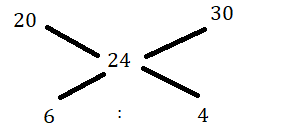
Ratio = 6: 4 = 3 : 2
2 units 🡪 10 kgs
3 units 🡪 15kgs
S20. Ans.(a)
Sol. Let the total profit be Rs 4x
Ratio of profit share of A and B is 6:7
Net profit of A = x + 6/13 × 2x = 3900
(25/13) x = 3900
x = 2028
4x = 8112
S21. Ans.(b)
Sol. Present age of his father = 40 years
Present age of Ankit = 40-32 = 8 years
Present age of his brother = 16 years
Sum of present ages of his brother and his sister = 14 × 2 = 28 years
Age of his sister = 28 – 16 = 12 years
S22. Ans.(e)
Sol. Cost price of the bat = 100/125 × 1000 = Rs 800
Profit= 1000 – 800 =Rs 200
For net profit to be zero there should be loss of Rs 200 on selling the ball
Loss % = 200/400 × 100 = 50 %
S23. Ans.(a)
Sol. If the youngest student and the oldest student are removed the average remains the same it means average age of the youngest and the oldest student is same i.e., 28 years
Let the age of the oldest student be 4x then the age of the youngest student will be 3x
4x + 3x = 56
x = 8
4x = 32years
S24. Ans.(e)
Sol. Initial quantity of milk = 7/13 × 208 = 112 liters
Initial quantity of water = 208 – 112 = 96 liters
Quantity of milk removed = 7/13 × 52 = 28 liters
Quantity of water removed = 52- 28 = 24 liters
ATQ,
(112-28)/(96-24+x) = 67
x = 26
S25. Ans.(a)
Sol. Let the upstream speed be 2x and downstream speed be x
ATQ,
64/x + 64/2x = 24
x = 4 kmph
2x = 8kmph
Speed of boat in still water = 4+82 = 6kmph
Required distance = 6 × 4 = 24 km
S26. Ans.(e)
Sol. The wrong number is 15.
Pattern of the series
S27. Ans.(d)
Sol. Wrong number = 300
Pattern of series –
S28. Ans.(e)
Sol. The wrong number is 51.
Pattern of the series
Difference should be alternate prime numbers
S29. Ans.(c)
Sol. The wrong number is 192.
Pattern of the series
667 – 272 = 395
395 – 136 = 259
259 – 68 = 191
191 – 34 = 157
157 – 17 = 140
140 – 8.5 = 131.5
S30. Ans.(a)
Sol. The wrong number is 264
Pattern of the series
4 + 60 = 5
5 + 61 = 11
11 + 62 = 47
47 + 63 = 263
263 + 64 = 1559
1559 + 65 = 9335
Solutions (31–35):
Let the total number of customers on Sunday be 100x
ATQ
18x – 12x = 150
6x = 150
x = 25
Customers of shop A = 18x = 450
Customers of shop B = 30x = 750
Customers of shop C = 12x = 300
Customers of shop D = 15x = 375
Customers of shop E = 25x = 625
Let the number of customers who went to saloon A for haircut, massage and shaving be 2a , 3a and 4a respectively.
2a + 3a + 4a = 450
a = 50
2a = 100
3a = 150
4a = 200
Similarly for other saloons
| SALOONS | Number of customers | Customers for Haircut | Customers for Massage | Customers for Shaving |
| A | 450 | 100 | 150 | 200 |
| B | 750 | 200 | 250 | 300 |
| C | 300 | 50 | 100 | 150 |
| D | 375 | 75 | 100 | 200 |
| E | 625 | 175 | 200 | 250 |
S31. Ans.(a)
Sol. Required ratio = 150/100 = 3/2 = 3: 2
S32. Ans.(c)
Sol. Required difference = (100 + 200) – (50 + 75) = 175
S33. Ans.(d)
Sol. Required percentage = [(200+250)-(200+75)]/275 × 100 = 63 7/11%
S34. Ans.(d)
Sol. Required ratio = (150+100)/(100+50) = 250/150 = 5: 3
S35. Ans.(e)
Sol. Required sum = 200 × 11/10 + 150 × 12/10 + 100 × 12/10 = 220 + 180 + 120 = 520
| Related Posts | |
| Union Bank SO Practice Set- Reasoning (With Answers) |
|
| Union Bank SO Syllabus | Union Bank SO Salary |
| Union Bank SO Previous Year Question Papers | |

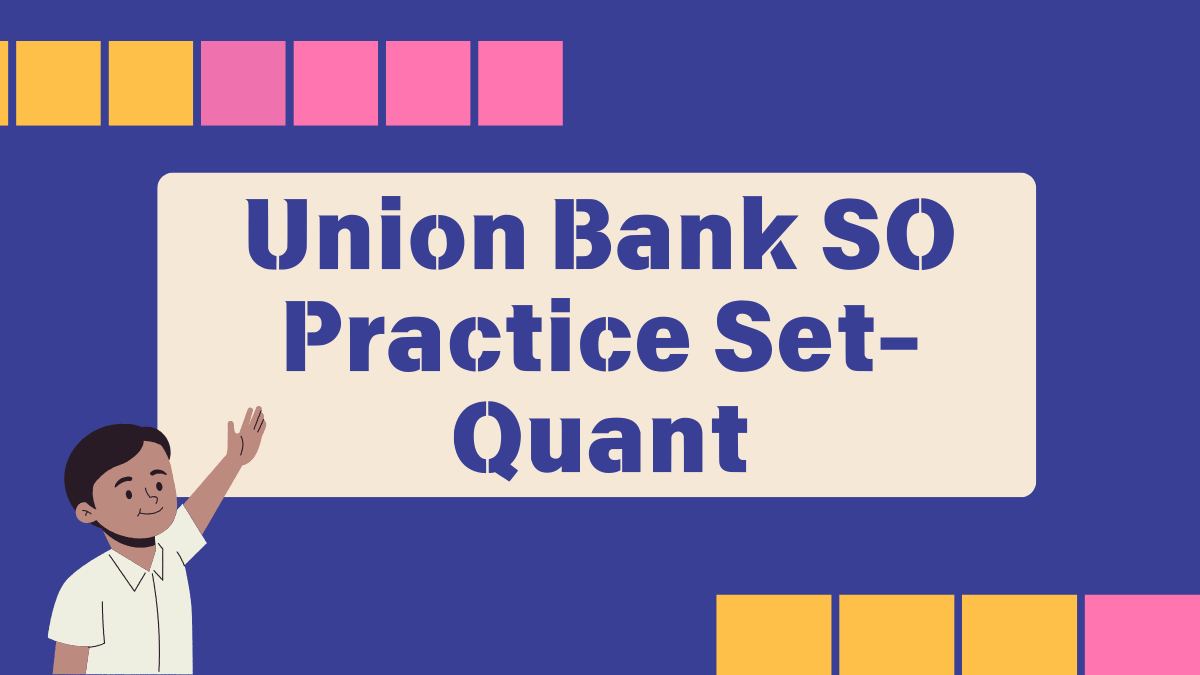


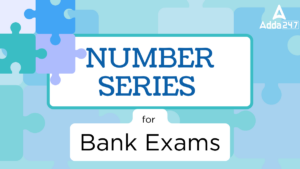 Number Series Questions for Bank Exams
Number Series Questions for Bank Exams
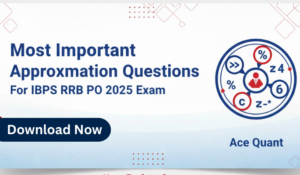 Most Important Approximation Questions f...
Most Important Approximation Questions f...
 Quadratic Equation Questions for SBI PO ...
Quadratic Equation Questions for SBI PO ...
